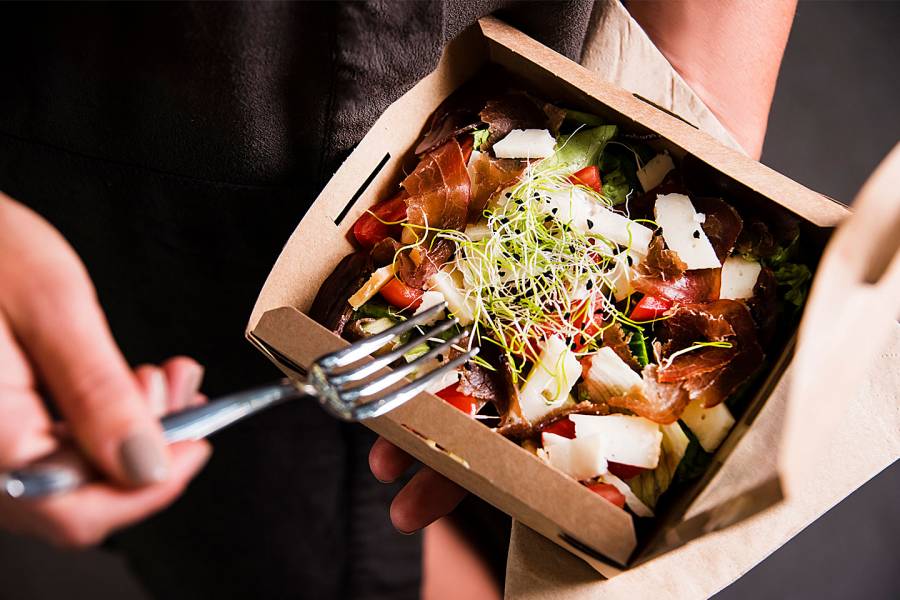This content is provided to Johns Hopkins employees through a partnership with EHP.
Good nutrition is an important part of leading a healthy lifestyle. Combined with physical activity, your diet can help you reach and maintain a healthy weight, reduce your risk of chronic diseases (such as heart disease and cancer), and promote your overall health. To make sure your diet is right for you, talk with your provider or schedule an appointment with a dietitian. Lead by example. Make healthy choices for yourself. Kids watch how and what you eat. They'll be more likely to eat healthy foods if you do.
Healthy restaurant options
Before you choose a restaurant, take a quick look at menus online to see which one provides the best options. Then consider these tips when ordering:
- If the restaurant's menu offers lighter fare and lists calorie counts, start there.
- Eat a small salad or broth-based soup first. It is a way to begin your meal and reduce the number of calories you consume.
- Choose vegetable-based meals or those with baked, broiled, or grilled fish or skinless chicken.
- Look for meals that are not greasy or oily. Instead of ordering cheese-covered chicken enchiladas, for example, get grilled chicken or fish tacos. Choose food items without creamy sauces or gravies.
- Ask to substitute vegetables or salad for fattening sides such as fries, coleslaw, or mashed potatoes.
- Portions served at restaurants can be large; see if smaller portions are available. Restaurants often offer "half" salads or sandwiches upon request.
- Ask for a "to go" bag and take home one-third to half of a large meal.
- If you crave dessert, choose fresh fruit or sorbet.
At the store
Do you shop at corner markets or convenience stores? You can find healthy foods for your family if you shop wisely. Follow these tips:
- Read the food labels to make healthier eating choices.
- Avoid breading and heavy sauces.
- Buy fresh or frozen vegetables.
- If you buy canned items, choose vegetables marked low sodium or no sodium and fruits packed in water or fruit juice. To make them even healthier, rinse off any extra salt or sugar.
- Choose whole grain products such as brown rice, corn or whole wheat tortillas, and whole wheat breads. Packages using enriched flour (vitamins and minerals removed) are not as healthy.
- Find sources of protein such as canned beans, tuna canned in water, eggs, low-fat or nonfat milk, and low-fat or nonfat cheese and yogurt.
- Stay away from snack foods. Don't be drawn in by chips, candy, soda, and sugar-filled pastries.
Better fast-food choices
Smart picks for a quick and easy meal are places where you have more control over what goes into your order. At a sandwich shop, it is easy to make healthy adjustments such as no mayonnaise, extra vegetables, and whole wheat bread instead of white. (Plus, these shops often have salads and soups as options.) Ethnic eateries that offer build-your-own bowls, vegetarian options, or grilled meat and vegetable plates are good bets, too. When passing through a traditional drive-thru, keep these tips in mind:
- Avoid fried foods (e.g., French fries, onion rings, chicken strips and nuggets).
- A grilled skinless chicken breast sandwich is lower in saturated fat than a burger.
- Order the smallest sizes. The kid's menu version of your favorite fast food can give you the taste you crave with far fewer calories.
- Do not "supersize" anything.
- Avoid calorie-heavy sides and toppings.
- Skip sugary drinks in favor of water, unsweetened tea, or fat-free or low-fat milk.
Home-cooked-meal kits
A large number of companies will box up and deliver multiple meals' worth of groceries to your house each week. The cost is more than if you did the planning and shopping yourself, but many people find the convenience worth it. You choose from a constantly rotating list of recipes (many companies offer low-carb, low-calorie, gluten-free, or vegetarian options), and when your meal box is delivered, you can follow the instructions to get portion-controlled dinners on the table in minutes.
Think balanced diet
Make sure you're getting a good mix of lean protein, vegetables, fruits, whole grains, and healthy low-fat dairy. With such a wide range of convenient meal options available—and the information you need to make smart, heart-healthy choices—you can feel good about what you eat even when life gets busy.
Posted in Health+Well-Being
Tagged hr newswire








